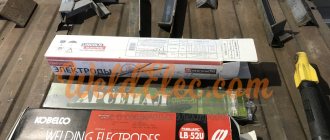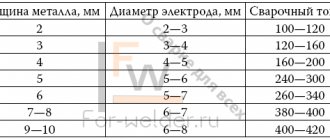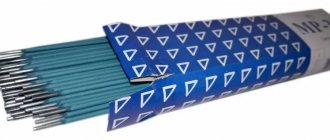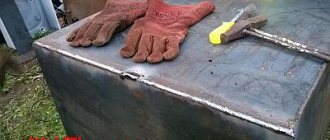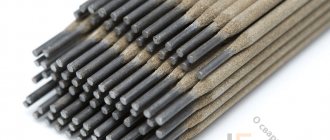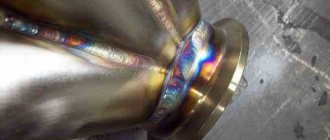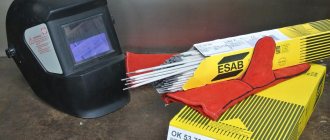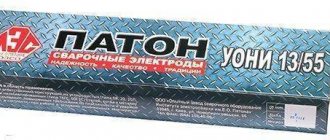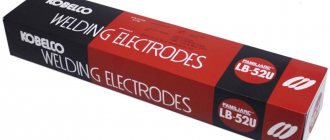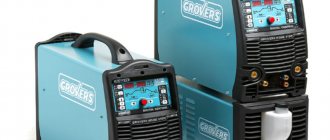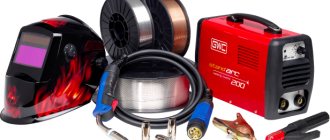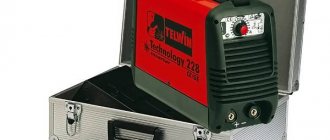| Place | Name | Characteristics in the rating |
| The best welding electrodes with basic coating |
| 1 | ESAB UONI 13/55 (350 x 3.0 mm; 4.5 kg) | Best price for basic electrodes |
| 2 | KOBELCO LB-52U (350 x 3.2 mm; 5 kg) | The best combination of price and quality |
| 3 | QUATTRO ELEMENTI 771-374 (350 x 2.5 mm; 0.9 kg) | The best combination of mechanical characteristics of the electrode metal |
| 4 | ESAB FILARC 88S (350 x 2.5 mm; 7.2 kg) | High quality of the resulting welded joints. Special Series |
| 5 | “KEDR” E 308L-16/OZL-8 (350 x 3.2 mm; 2 kg) | The best basic coated electrodes for welding high alloy steels |
| The best rutile coated welding electrodes |
| 1 | ESAB OK 46.30 (450 x 5.0 mm; 18.9 kg) | The most economical electrodes |
| 2 | Quattro Elementi 772-166 (300 x 2.0 mm; 3 kg) | High degree of popularity |
| 3 | "Resanta" MR-3S (350 x 3 mm; 3 kg) | The most favorable price offer |
| 4 | Inforce MP-3 11-05-01 (450 x 5 mm; 5 kg) | Balanced mechanical performance |
| 5 | ELITECH MP-3C (350 x 3 mm; 5 kg) | Optimal combination of price and quality of the deposited layer |
| Best Cellulose Coated Welding Electrodes |
| 1 | ESAB Pipeweld 7010 Plus (350 x 4.0 mm; 20 kg) | Good resistance of electrodes to overheating |
| 2 | "SpetsElectrode" MP-3S (450 x 4 mm; 5 kg) | High welding conditions without preliminary metal preparation |
| 3 | "Monolith" RC ANO-36 (4 mm; 5 kg) | Best price |
| Best Acid Coated Welding Electrodes |
| 1 | ESAB OK 67.71 (350 x 3.2 mm; 4.8 kg) | Wide range of applicability. High quality welds |
| 2 | ESAB OK 61.20 (30 x 2.5 mm; 4.2 kg) | Optimal cost parameters |
Welding electrodes are a mandatory consumable material used during welding operations. Its essence lies in introducing additional (electrode) metal into the weld pool formed when the base metal melts in the weld zone. The result of this action will be a permanent connection capable of absorbing various types of loads and ensuring rigidity or tightness (in the case of pipe welding) of the structure.
Simple in words, in reality this process requires a fair amount of preparation, including in terms of selecting electrodes. It is not enough to select a consumable element with a metal whose properties are as close as possible to the main one. The market is gradually filled with competing products, so even professionals, let alone novice users, often fail to make the right choice in such an environment. After studying reviews from consumers and experts, we have prepared for you a rating of the best welding electrodes, divided into four main categories.
The best welding electrodes with basic coating
Electrodes with a basic coating are used quite often, since they do not impose strict restrictions on welding. The parts to be welded can be oriented in space at any angle - the electrode works in all spatial positions. In addition, not only thin metal products can be subjected to the process of obtaining a permanent connection - thick sheets of metal and thick-walled structures are also subject to welding with the main electrode. The only condition: these processes must take place at a constant current of reverse polarity.
Electrode selection criteria
First of all, it should be borne in mind that electrodes can be of consumable and non-consumable type. The first ones are made of a metal rod, onto the surface of which a special coating is applied, which helps protect the welding zone and increases the stability of the arc. They are used to perform manual arc welding. Products of the second category - non-consumable - are used to perform welding work in a shielding gas (argon), their varieties and features of use will be discussed in a separate article.
» data-lazy-type=»iframe» src=»data:image/gif;base64,R0lGODlhAQABAIAAAAAAAP///yH5BAEAAAAALAAAAAABAAEAAAIBRAA7″>
When choosing electrodes for welding using an inverter, you should take into account that the material of the parts being joined will also affect the quality characteristics of the seam being formed. Accordingly, in order to weld different materials, different types of welding electrodes are used. So, for example:
- to connect products made from low-carbon and low-alloy steel grades, carbon electrodes are chosen;
- to connect products made of alloy steel, electrodes of the corresponding brands are used: OZS-4, MR-3 (GOST 9466-75), MR-3, ANO-21, UONI 13/45 (GOST 9467-75);
- if it is necessary to carry out welding work with surfacing or other types of steel, then choose electrodes with a core made of high-alloy metal - TsL-11 (GOST 9466-75);
- in order to cook cast iron, it is also necessary to select electrodes of the appropriate brand - OZCH-2 (GOST 9466-75).
General view of MP-3 electrodes
To date, the following rating of electrodes used for welding using an inverter has been formed.
- ANO. Welding electrodes of this brand are highly flammable and do not require additional calcination. Both novice welders and professionals can work with them equally successfully.
- MP-3 is a universal type; they can even be used to connect uncleaned surfaces.
- MR-3S. Electrodes of this brand should be chosen if increased demands are placed on the characteristics of the seam.
- UONI 13/55 is used for installation of critical structures that require high quality welds. It will be difficult for a novice welder to work with them: their use requires certain experience and high qualifications.
Electrodes UONI 13/55
The best rutile coated welding electrodes
Rutile electrodes have gained great popularity among welders due to a combination of useful characteristics. They have easy ignition, are highly resistant to moisture, and can also be used on direct and alternating current. Their disadvantages include the impossibility of welding structures made of high-carbon steel, the direct dependence of the quality of the seam on the welding modes, as well as the need for careful preparatory operations (such as drying and calcination of the surface).
What is an electrode and what is the coating for?
An electrode is a piece of metal wire with a special coating - coating. During welding, the core melts due to the temperature of the arc. At the same time, the coating burns and melts, creating a protective gas cloud around the welding area - the weld pool. It blocks access to oxygen contained in the air. As the coating burns, part of it turns into a liquid state and covers the molten metal with a thin layer, also protecting it from interaction with oxygen. So the coating ensures good quality of the seam.
The welding electrode consists of a core and a protective coating
Before starting welding, any electrode is inspected: the coating should not be chipped. Otherwise, you will not achieve uniform heating and a high-quality seam. Also pay attention to the tip of the electrode: the thickness of the coating should be the same on all sides. Then the arc will come out in the center. Otherwise it will be displaced. For experienced welders this is not a big deal, but for beginners it can create significant problems.
It is necessary to monitor the moisture content of the coating. Some of them ignite very poorly in high humidity (for example, SSSI). Due to such “capriciousness” of the coating, they need to be stored in a dry place, ensuring as airtight packaging as possible. You can put the box in a bag, and also put in a few bags of salt that come in shoe boxes.
You should not buy wet electrodes: they can, of course, be dried, but their characteristics will decrease. If it does happen that the electrodes become damp, you can dry them in a regular household oven at low temperatures (they are usually indicated on the packaging). The second way is to put it in a dry, well-ventilated area for a long time.
Coating (protective coating) of electrodes can be: basic, rutile, cellulose and acidic.
Types of coating and their characteristics
There are only four types of coatings:
- Basics.
- Rutile.
- Sour.
- Pulp.
Basic (USSI) and cellulose coatings are only suitable for DC welding. They can be used on critical seams: they create a strong, elastic seam that is resistant to impact loads.
There are more than 200 brands of electrodes for welding, about 100 of them can be used in manual arc welding
The other two (rutile and acidic) can work with both alternating and direct current when welding. But acidic coating is very toxic: you can work indoors only if the workplace is equipped with forced exhaust.
Rutile coating has a greenish or blue tint, the electrodes are easy to ignite. They ignite well even if the inverter has a low open circuit voltage (for reliable ignition of the main coating, a good current-voltage characteristic is required; how to choose an inverter welding machine, read here.). When welding with rutile electrodes (MP-3), the metal hardly splashes, but there is a lot of slag and it is not easy to remove: you have to work with a hammer.
You may be interested in how to weld a gazebo from a metal pipe or how to make a shed on a pipe frame.
This is interesting: Corrugated stainless pipe: production and application features
How to properly use an inverter welding machine
In experienced hands, an inverter can produce a good seam; you need to follow three rules:
- set the optimal current strength;
- choose the correct electrode diameter;
- take into account the thickness of the parts being welded.
Diameter is the main guarantee of a high-quality seam, and the current density also depends on it. The density cannot be higher, because the arc will be unstable, which means the metal will not be welded as well and the seam will be wider.
Of course, this will not affect the quality, but if aesthetics are important, then it is better to avoid it. If you need to cook thin products, it is better to use a semi-automatic machine.
Inverter welding will produce an unreliable seam, and when choosing thick welding rods, pores will appear in the joint, which will reduce its strength.
To find out the optimal current strength when working with the selected rods, just look at the markings on the packaging. It is not recommended to deviate from this parameter.
Differences in electrodes by brand and diameter
There is an opinion among experienced welders that when using an inverter, you can weld with any electrodes. As a rule, such an opinion is based only on the personal experience of such specialists engaged in performing work of a certain type (welding structures from profile pipes or angles). When performing work using an inverter, no serious requirements are placed on the connection regarding its tightness, so electrodes with a diameter of 0.5–2 mm can be used without problems.
The choice of diameter and brand of electrode should be based on the thickness of the metal that needs to be connected with them. Parts of large thickness require long-term welding; accordingly, the electrode for welding them must be selected with a larger diameter. You still need to learn how to work with small-diameter welding electrodes; they burn out very quickly. Typically, such products are used for tack work.
» data-lazy-type=»iframe» src=»data:image/gif;base64,R0lGODlhAQABAIAAAAAAAP///yH5BAEAAAAALAAAAAABAAEAAAIBRAA7″>
Which electrodes are best to choose is also influenced by the type of work for which they are planned to be used. Thus, to perform complex route work, it is necessary to select electrodes of large diameter, and the installation of structures from profile elements can be carried out with products with a diameter of up to 2 mm. These electrodes are used, in particular, in the installation of sectional doors and the manufacture of various enclosing structures from profile pipes and corrugated sheets.
User voting
Which welding electrodes would you choose or recommend?
Kobelco LB-52U
10.55 % ( 56 )
ESAB SSSI 13/55
8.47 % ( 45 )
Cedar OZL-8
2.26 % ( 12 )
Lincoln Electric SSSI 13/55
6.59 % ( 35 )
Wester UONII-13/55
1.88 % ( 10 )
ESAB-SVEL OK 46.00
32.58 % ( 173 )
Resanta MP-3
21.66 % ( 115 )
Fubag FB3
8.29 % ( 44 )
Sibrtech MP-3C
3.20 % ( 17 )
Selection of products according to other parameters
The type of current, as well as the polarity of its connection, are the most important parameters of welding operations. Welding inverters primarily produce direct current, which can be connected to the workpiece and the electrode in two circuits.
- Straight polarity. With this scheme, the plus is connected to ground, and the minus to the welding electrode.
- Reverse polarity. This scheme involves connecting the minus to ground, and the plus, respectively, to the holder with the electrode.
If you cook with an inverter using straight polarity, the surfaces being connected are subject to significant heating, which does not happen when connecting the polarity in the opposite way. This is why choosing reverse polarity is advisable in the following situations.
- When welding parts of small thickness with an inverter. Reverse polarity in such cases will help protect the material from burn-through.
- Reverse polarity is used to weld parts made of high-alloy steels, which are very sensitive to overheating.
Working with inverter welding
Direct polarity, during which the workpiece is subjected to significant heating, is optimally used for joining materials that are very thick and massive.
When performing any welding work using an inverter, the most significant are three parameters that are interconnected:
- welding current strength;
- electrode diameter;
- thickness of the parts to be connected.
The thickness of the parts being connected has a direct influence on the choice of electrodes. If it is necessary to connect thin parts (up to 1.5 mm), manual welding is not used; semi-automatic machines or devices that allow welding in a protective argon environment are better suited for this purpose.
Options for electrode position when welding
When deciding which electrodes to choose for welding structures of a certain thickness, you can be guided by the following criteria:
- for parts whose thickness is 2 mm, electrodes Ø 2.5 mm are best suited;
- when connecting parts with a thickness of 3 mm, you should choose electrodes Ø 2.5–3 mm;
- if the thickness of the parts to be welded is 4–5 mm, then electrodes Ø 3.2–4 mm are suitable;
- parts with a thickness of 6–12 mm are best welded with electrodes Ø 4–5 mm;
- when the thickness exceeds 13 mm, then the optimal choice is electrodes Ø 5 mm.
It is very important to choose the correct diameter of the electrodes, since if this parameter is exceeded, the welding current density decreases. This will lead to the welding arc becoming unstable, the penetration of parts will deteriorate, and the width of the weld will increase. Many manufacturers indicate on the packaging information about the best current values to use.
Welding electrodes
If such information is not contained on the packaging, then you can follow the following recommendations:
- for welding with electrodes Ø 2 mm, the welding current should be set to 55–65A;
- for products Ø 2.5 mm, a current of 65–80A is used;
- electrodes Ø 3 mm - current 70–130A;
- for electrodes Ø 4 mm, choose a welding current of 130–160 A;
- products Ø 5 mm - current 180–210 A;
- It is better to cook with 6 mm electrodes at a current of 210–240 A.
As it becomes clear from all of the above, for high-quality welding with an inverter, the correct choice of electrodes according to their diameter is important. You should also set the optimal welding current. If, for example, you plan to weld thin metal with an inverter, using large-diameter electrodes, or the welding current exceeds the permissible values, then pores may form in the finished weld, which will significantly reduce its quality characteristics.
» data-lazy-type=»iframe» src=»data:image/gif;base64,R0lGODlhAQABAIAAAAAAAP///yH5BAEAAAAALAAAAAABAAEAAAIBRAA7″>
